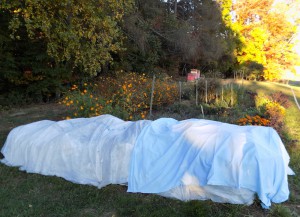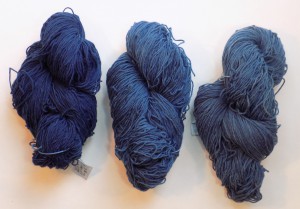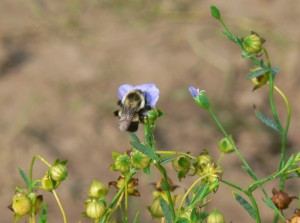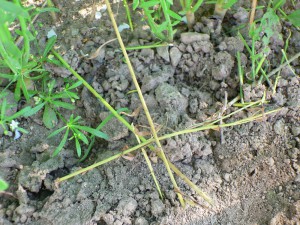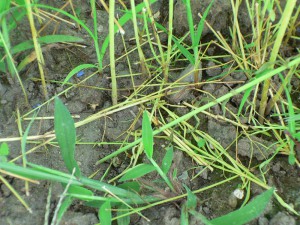We’ve had a pretty mild winter thus far around here. Today, though, I have a snow day so I’m catching up on a post I started writing ages ago. This post is about nursing my Japanese indigo plants through the frosts in the fall. When the first frost was forecast on October 10, 2015, I bundled up the plants nice and snug.
Wrapping Up A Loose End
I have not done much dyeing lately. My last dye day was on September 6th when I ran my second Japanese indigo vat. Since then, I managed to rinse and dry the skeins, but didn’t get much further than that. They’ve been sitting in a tub waiting for closure. On New Year’s Eve I finally wrapped up that loose end.
As I noted in my original post, I don’t have good photo-documentation about that vat. But at least now I can show you photos of the skeins I dyed. All the yarns are wool. Here are the blue skeins.
What Are Those Bees Doing?
This is yet another post in which I attempt to catch up on the wealth of observations from the summer’s flax project. In this post I will share a lot of photographs of bees. Photographing bees and other flying insects isn’t easy. However, my certainty that bees visit flax blossoms was the main reason that I was worried about cross-pollination when I was setting up my USDA seed project this spring. It’s the reason I covered the plants, even though flax is considered self-pollinated. I’m not sure what bees and other insects are doing, exactly, when they visit flax flowers. I just know that they do.
Here’s a bee visiting a flax flower on July 29, 2015.
I didn’t make note of what variety it was on. Continue reading “What Are Those Bees Doing?”
More About Flax Seed Maturity
This is a follow-up to my recent post about fiber flax seed maturity. After I posted it, I realized that I have a lot more photographs depicting the things I was trying to describe. So, here’s a bit more visual detail.
Let’s revisit the problem of dehiscence. This would mean that mature/over-ripe seed pods, bolls, or capsules would a) fall intact from their teeny withered stems onto the ground or b) shatter, pop open, and drop their glossy seeds willy-nilly on the ground. As a seed-saver, I was not in favor of either of these possibilities. Continue reading “More About Flax Seed Maturity”
Saving Flax Seed: Days to Maturity
This is the next installment about the USDA germplasm project I have been working on this year. In this post I will discuss the definition of “days to maturity”, which was one of the pieces of information I was supposed to be tracking for the USDA. I will also share some of my thinking around how I decided to harvest seeds this summer.
Since there has been a significant lapse of time since my last flax-related post, I will quickly recap. In this first season of the project, I was hoping to increase our supply of seed. I tried to prevent cross pollination by using isolation cages made out of lightweight Agribon and wooden stakes. Half of my project suffered utter crop failure in mid-July due to predation by rodents (or possibly other unidentified flax-stalk chewers and flax-seed eaters). Luckily, the other half of the project escaped largely unscathed, thanks to better weeding, daily monitoring, and cat-pee soaked scraps of cloth pinned to the isolation cages. You can read my earlier posts from April to August of 2015 for more details. Continue reading “Saving Flax Seed: Days to Maturity”
The Hurrier I Go
Life has been very busy. Back in July I kept thinking, “July is the month of everything.” Dye plants blooming, flax needing to be harvested, NEH summer institute, NEWS, family weekend at Queen Lake, hiring a new co-worker at school…. I did a lot, but since I can’t do everything, I had to let a lot of things go. No goldenrod or Queen Anne’s lace dye baths this year, and I missed Peggy Hart‘s talk on the history of NEWS, for example. (12/30/2023 Edited: Here are updated links to the National Endowment for the Humanities Summer Institute and New England Weavers Seminar.)
Then when August came, I thought, “No, August is the month of everything.” Even *more* dye plants blooming, flax *really* needing to be harvested, prepping for school, getting to know my new co-worker…. I did a lot, but ditto July. I had to let a lot of things go. No flax retting experiments. No purple loosestrife or black walnut experiments, despite an absolutely ridiculous abundance of wild dye plants. Very few orange cosmos flowers were collected and frozen. No woad was cut or dyed with. The flax and linen study group website was not updated. Continue reading “The Hurrier I Go”
Japanese Indigo Vat At Last
Last year at the Massachusetts Sheep and Woolcraft Fair I bought several Japanese indigo plants (Polygonum tinctorum, though I’ve heard that perhaps the name has changed). I was very excited and intended to dye with them, but then next thing you know, summer had raced past and they were blooming. I was worried that they would have lost a lot of their color once they started to bloom. And I was worried that I might have a hard time finding plants or seeds again. I decided I’d save them for seed and not use them for dyeing after all. You can recap a couple posts from last year here. And here.
This spring I successfully grew about 40 seedlings, half of which I put in at Bramble Hill Farm and the other half at our community garden plot. I guess I was in a “don’t put your eggs in one basket” mode this spring. Very wise, as it turned out. Continue reading “Japanese Indigo Vat At Last”
Anti-Rodent Action
After I discovered the rodent catastrophe at our community garden plot, I fearfully headed over to the other site at Amethyst Farm to assess the situation there. Some damage had already occurred, but it was really minor in comparison.
Here are some chewed up stems from the type nick-named 448, and another variety that I apparently forgot to make note of below that.
Rodent Apocalypse
I’ve been putting off writing this post for a while because the events I’m about to relate are extremely regrettable and sad. Well, to me anyway. I cried a lot. However, it was also an opportunity to learn about the perils of seed saving first hand, so I am now ready to reluctantly admit that it was a learning experience.
Back in July I was very busy. I was in a National Endowment for the Humanities summer institute for K-12 teachers at UMass on the history of Native Americans in New England. (12/28/2023 Link updated). We met from 9-4 each day, and at night I worked on the reading, homework, and culminating project. It was an excellent program and I was very grateful for the opportunity to learn from fantastic, creative scholars and activists. However, it also meant that I didn’t have time for other things, including flax. I’d been checking on the flax periodically, but didn’t devote as much attention to it as I would have liked. So, I was very excited when the institute was over and I could re-prioritize my flax experiment. Continue reading “Rodent Apocalypse”
Flax Pollination and Isolation Part Two
After deciding that I would use a physical barrier to keep the flax varieties isolated, the next step was to design and build the isolation tents. I wanted to use supplies that could be re-used for other purposes in the future, which ruled out building cages with hammer and nails. Instead I bought 108 4-foot wooden stakes from Amherst Farmers Supply (four stakes for every little bed). To me this is a lot of stakes, and I thought I might have to place a special order, but no! They have literally thousands in stock, so I was able to pick them up the very same day I went in. Continue reading “Flax Pollination and Isolation Part Two”

